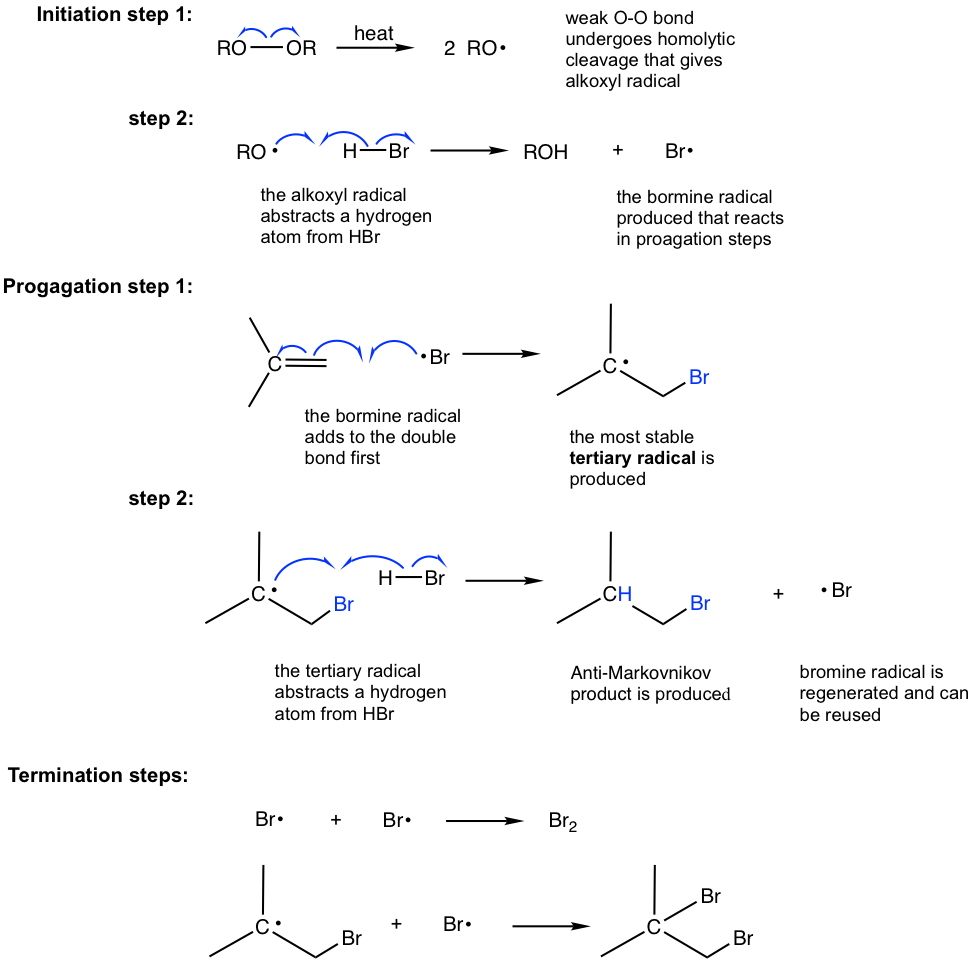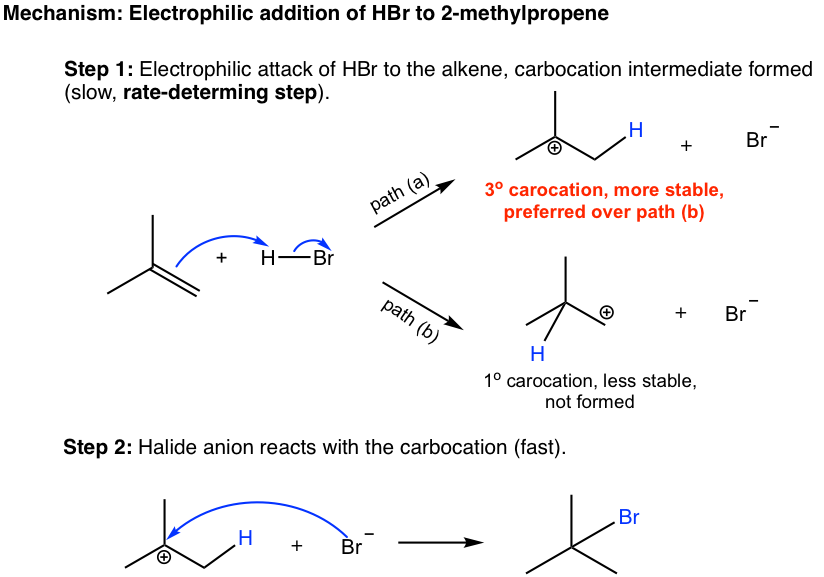Addition of Hydrogen Halides to Alkenes Mechanism
For instance alkanes alkynes or alkenes the amount of bonded hydrogen decreases in alkenes and alkynes. Dehydration can be performed in a 3-step mechanism.

10 2 Reactions Of Alkenes Addition Of Hydrogen Halide To Alkenes Organic Chemistry I
In hydrogenation the resulting alkyl ligand combines with a second hydride to give the alkane.

. Mechanism The mechanism of the reaction involves the following three steps. A second area of long-standing interest is the fixation of molecular nitrogen N 2While the industrial Haber-Bosch process has had a transformative impact on society enabling food production for approximately half of the worlds population and accounting for half of the nitrogen in the body the fossil fuel inputs and carbon footprint associated with this reaction inspire. S N 1 S N 2 E1 or E2 the Largest Collection of Practice Problems.
From alkenes i By acid catalysed hydration. The ability of hydrocarbons to bond to themselves is known as catenation. Electrophilic addition to conjugated dienes occurs through 12 and 14-addition mechanism out of Q.
The carbonyl compounds in which carbon of carbonyl group is bonded to carbon or hydrogen and oxygen of hydroxyl moiety -OH are known as carboxylic acids while in compounds where carbon is attached to carbon or hydrogen and nitrogen of -NH2 moiety or to halogens are called amides. Theres no warning sign saying wait. Only one textbook in this admittedly incomplete sample mentions the S N i mechanism at all.
Acid-Catalyzed Hydration of Alkenes with Practice Problems. Drawing alkene formulas from names. Gabriel Phthalimide Synthesis was discovered by a German chemist named Siegmund Gabriel.
Markovnikovs Rule with Practice Problems. Drawing alcohol formulas. Drawing formulas from names.
The elements of water can be added to the doublebonded carbons of an alkene in either a Markovnikovs or an antiMarkovnikovs manner. As shown in the following figure a hydrogen ion catalyzes the Markovnikovs addition. The Role of the Solvent in S N 1 S N 2 E1 and E2 Reactions.
The Gabriel synthesis is a chemical reaction used to obtain primary amines from primary alkyl halides. The antiMarkovnikovs addition results from a hydroborationoxidation reaction. If the two carbon atoms at the double bond are linked to a different number of hydrogen atoms the halogen is found preferentially at the carbon with fewer hydrogen.
Hydrogen halides react with alkynes in the same manner as they do with alkenes. The mechanism of alkyne hydrogenation is identical to that of the alkenes. Formation of alkenes.
Alkenes react with water in the presence of acid as catalyst to form alcohols. Drawing formulas from names. Analogous reactions apply to the hydrogenation of.
Similarly groups that favor ionization of the halogen may generate a transition state with substantial positive charge on the alpha-carbon and only a small degree of CH breaking. A recent application is the generation of highly reactive aryl radicals which are useful arylating reagents in synthesis by photoinduced electron transfer PET from photoredox catalysts to suitable precursors followed by bond scission 8 9However the choice of aryl radical precursors is currently limited to electron-poor arenes such as diazonium 6 10 or. With such capabilities they can.
Formation of protonated alcohol. The primary alcohols elimination reactions follow the E2 mechanism whereas the secondary and tertiary alcohols. Drawing alkyne formulas from names.
In case of unsymmetrical alkenes the addition reaction takes place in accordance with Markovnikovs rule Unit 13 Class XI. The insertion of alkenes into metal-hydrogen bonds is a key step in hydrogenation and hydroformylation reactions. This is mainly due to the self-bonding or catenation of carbon that prevents the complete saturation of the hydrocarbon by the formation of double or triple bonds.
If its not in the textbook chances are it. Matching alcohols to their names I. Visit Friedel Crafts Reaction for an in-depth explanation of the reaction details and mechanism.
The S N 2 doesnt happen for secondary alcohols. Both steps in the above addition follow the Markovnikov rule. Carbon and hydrogen while in the ketones it is bonded to two carbon atoms.
Given that i Ni0 complexes undergo oxidative addition more readily than NiI complexes with aryl halides and ii NiII complexes are believed to rapidly engage with sp 3 carbon-centered radicals to form NiIII species enabling sp 3 sp 2 and sp 3 sp 3 CC bond formations 15 16 we favor the dual-catalysis mechanism outlined in Fig. For example if the Rgroups on the beta-carbon enhance the acidity of that hydrogen then substantial breaking of CH may occur before the other bonds begin to be affected. Because the hydrogen is absorbed on the catalyst surface.
The reaction involves the alkene and the hydride ligands combining within the coordination sphere of a catalyst. A stereochemical study revesled. Delydrobalogenation of vinyi halides is essentially an E2 process.
S N 1 S N 2 E1 E2 How to Choose the Mechanism. CH 3 CHCH 2 HI CH 3 CHICH 2 H. In four textbooks where SOCl 2 is mentioned the reaction is shown as proceeding through an S N 2 mechanism.
Drawing formulas from names. Addition Reactions of Alkenes. Dehydration of alcohols follows the E1 or E2 mechanism.
Thus the addition of hydrogen bromide to 1butyne gives 2bromo1butene as the major product of the. Hydrohalogenation is the addition of hydrogen halides such as HCl or HI to alkenes to yield the corresponding haloalkanes. Mechanism of Dehydration of Alcohols.

Electrophilic Addition Of Hydrogen Halides To Alkenes Youtube

9 2 Addition Of Hydrogen Halides To Symmetrical Alkenes Chemistry Libretexts

10 2 Reactions Of Alkenes Addition Of Hydrogen Halide To Alkenes Organic Chemistry I

Electrophilic Addition Of Hydrogen Halides Chemistry Libretexts
No comments for "Addition of Hydrogen Halides to Alkenes Mechanism"
Post a Comment